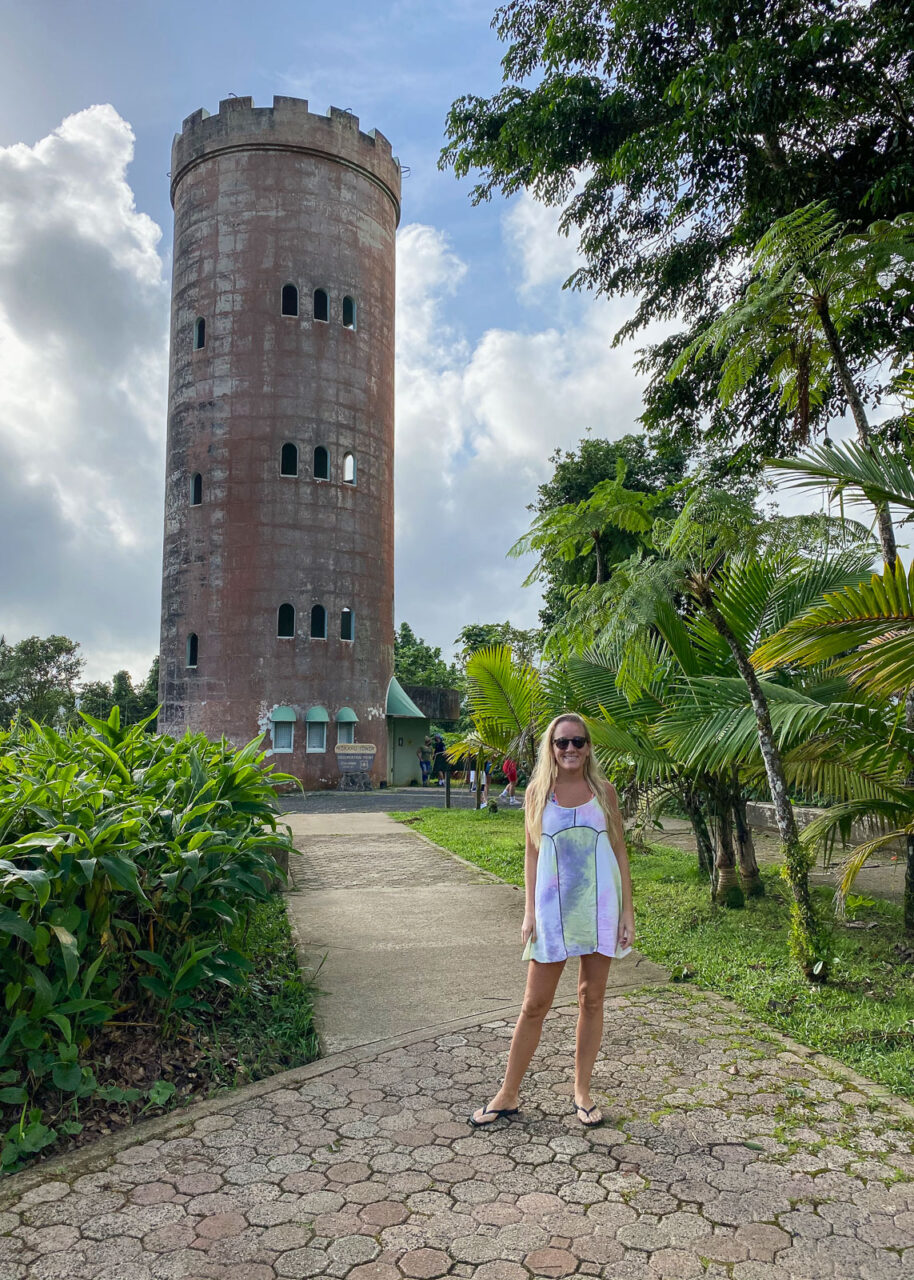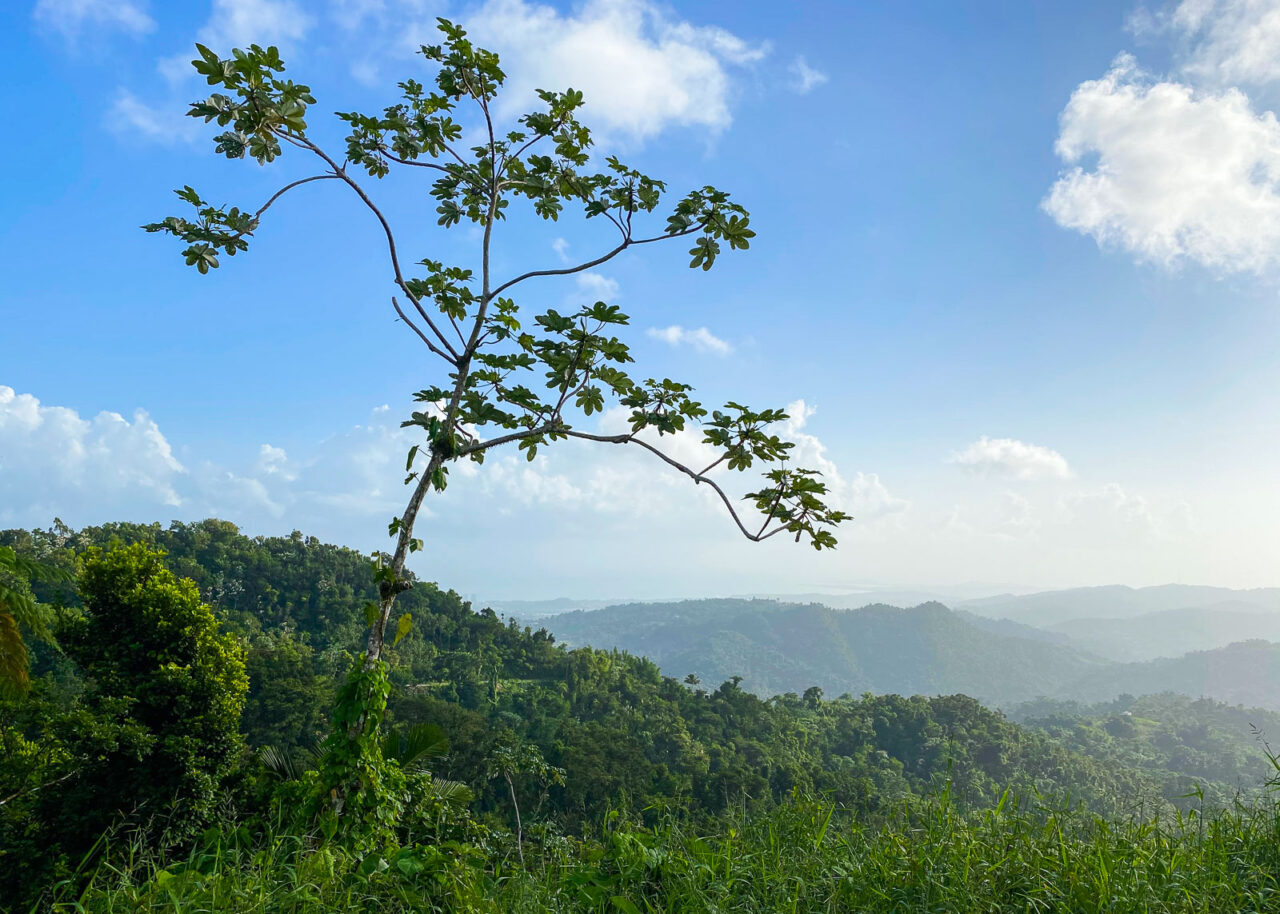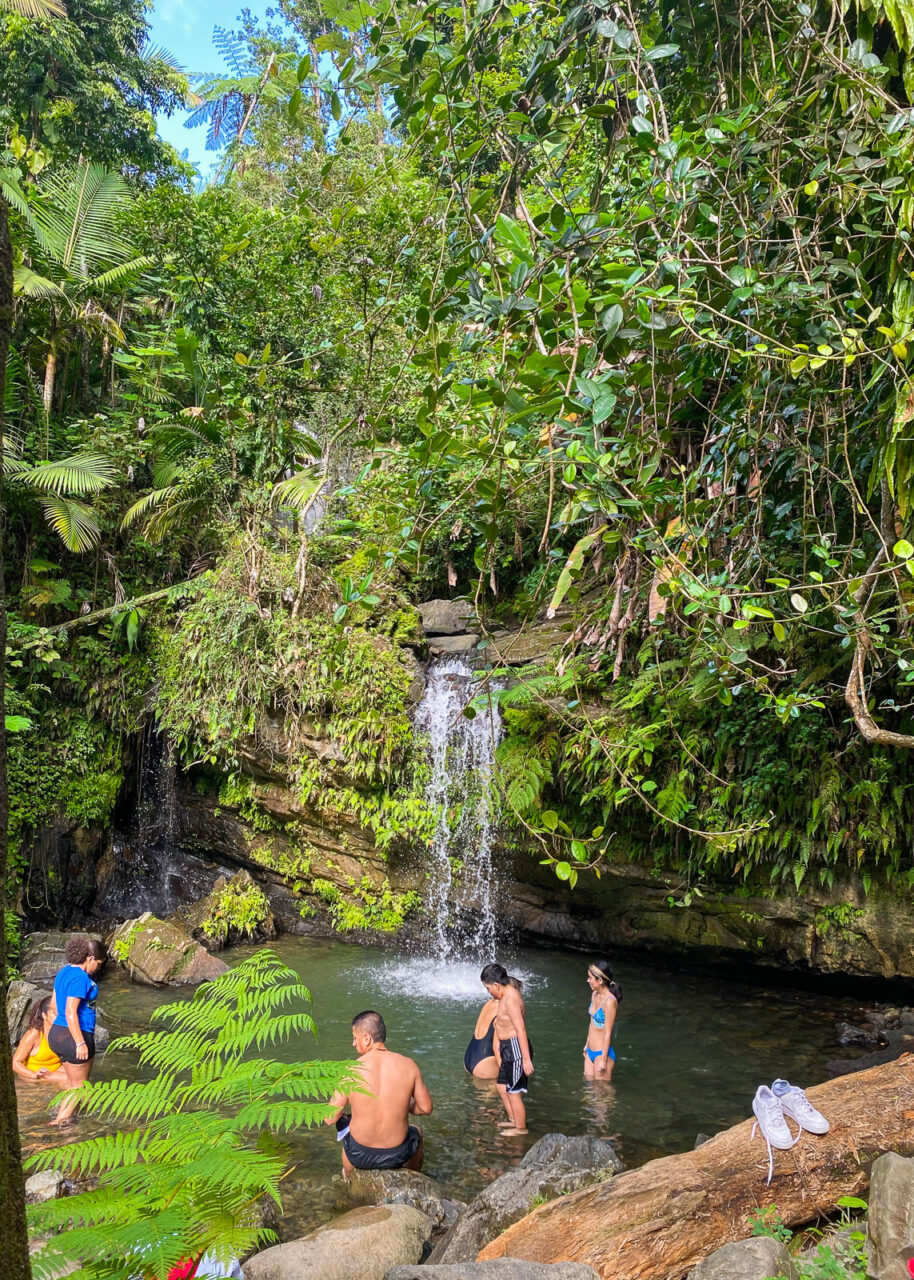
Heads up: some of the links on this site are affiliate links. If you click and make a booking or purchase, I’ll make a commission (at no extra cost to you). I partner with companies I personally use and the $$ goes towards creating more awesome, free travel content.
If you’re planning a trip to Puerto Rico, make sure you include a trip to El Yunque National Forest, which is the only tropical rainforest in the U.S. National Forest System. It’s home to all sorts of plant and animal species, as well as waterfalls, hiking trails and natural pools. The views from the rainforest are stunning, and there are numerous lookout points where you can stop and take photos.
Visiting El Yunque rainforest on your own takes a little bit of planning, since you’ll need to book a timed reservation and also hire a car to get there. If you’d prefer to leave the planning to someone else, you could also book a tour online through GetYourGuide or Viator.
In this guide you’ll find everything you need to know about visiting El Yunque National Rainforest, including how to get there and things to do in the area.
Where is El Yunque?
El Yunque National Forest is located in the Sierra de Luquillo mountains, around 45 km southeast of San Juan. It’s close to Luquillo and Fajardo, so you could combine your El Yunque visit with a bioluminescent bay kayaking tour and a visit to Luquillo Beach.
Why is El Yunque Famous?

El Yunque is famous for being the only tropical rainforest in the U.S. National Forest System. It’s one of the smallest forests, covering an area of just 29,000 acres, yet it’s the most biologically diverse.
Around 750 different plant species, 250 types of trees, 11 types of bats and 79 types of birds inhabit this magical place. The rainforest is also an important source of freshwater, supplying around 50 million gallons a day to the people of Puerto Rico.
The island’s first inhabitants, the Taínos, viewed El Yunque as a sacred place, and it has become an important part of Puerto Rico’s national heritage. The Tainos people believed that their chief god Yocahu lived in the mountains of the rainforest and protected them from the god Juracán (also known as Huricán), who was responsible for hurricanes.
Many people believe the name El Yunque comes from the Taíno word Yuque or Yuké, which means “White Earth”, due to the white clouds that cover the mountains. Today, El Yunque receives around 900,000 visitors per year and is one of Puerto Rico’s most popular attractions.
How to Get to El Yunque from San Juan

By Car
If you’re traveling by car, the quickest way to get there from San Juan is by taking PR-66 (toll road) until it ends and then driving on PR-3 for around 6.3km. You’ll then take PR-191 for about 3.1km till you eventually reach the rainforest.
Just type in El Portal de El Yunque Visitor Center in Google Maps. The address is PR-191, Río Grande, 00745, Puerto Rico.
There are numerous car rental companies with offices at San Juan airport and Isla Verde. I usually use Rentalcars.com, Discover Cars and Priceline to compare prices.
When you pick up your car rental the company will ask you if you want to include tolls. Tolls can’t be paid in cash, so you’ll have to pay a daily rate with the car rental company. If you refuse the toll add-on, make sure you avoid the toll roads otherwise you’ll have to pay a penalty fee per toll violation.
Sometimes PR-191 can be closed due to adverse weather conditions, so always check for closures online at the park’s official website before you go.
Tours
If you don’t want to deal with the hassle of renting a car, you can book a tour online using GetYourGuide or Viator. Tours will usually pick you up from your hotel in San Juan. Check out the following tours:
El Yunque Tickets

If you plan on driving to El Yunque yourself you’ll need to book a timed reservation through the following website: https://www.recreation.gov/ticket/facility/300017. There are usually two time slots; one at 8am and one at 11am to 2pm.
The fee is $2 per car, and the ticket is non-refundable. Tickets are released 30-days in advance of the entry date at 10am Eastern Standard time.
An additional number of tickets are released 24 hours in advance, starting at 8am of each day. If you’re planning a last minute visit, make sure you set your alarm for 8am the day before you want to visit, as they can sell out.
Visitor capacity is about 300 vehicles per day, so the roads at El Yunque can get pretty busy. Ideally it’s best to pick the morning slot (8am to 11am) as you’ll experience less traffic. We arrived early and had no trouble parking at all the lookout spots. But when we were driving back towards the Visitor’s Center, we passed lots of cars traveling in the other direction.
El Yunque Opening Hours
The forest is available daily (except for Christmas) from 7:30am to 5pm. El Portal Visitor Center is open from 9am to 5pm.
Things to Do in El Yunque National Forest

Driving El Yunque in your own vehicle gives you the freedom to stop wherever you like. There are lots of observation points, hikes and waterfalls along the way. You’ll enter at the Visitors Center, then drive up the mountain passing various attractions along the way. Here are some of the best things to do in El Yunque National Forest:
El Portal Visitor Center
When you enter the park, the first attraction you’ll come across is the beautiful El Portal Visitor Center, which is the largest visitor center in the National Forest System. There’s an accessible interpretive trail encircling the property, along with exhibits, interpretive programs, restrooms, a gift shop, and a café. You’ll also be presented with opportunities to spot the endangered Puerto Rican Parrot. Entry costs $8.
Hikes

One of the most popular activities in El Yunque is hiking. The rainforest boasts numerous hiking trails and natural pools where you can take a dip and cool off. And if you want to plunge into the water from a rope swing, check out El Angelito trail, which has a swing at the end of its 4km (2.5 mile) hike.
Caimitillo Trail
Caimitillo Trail is one of the easiest trails in El Yunque, involving a short 0.4 to 0.6 mile walk. Starting around 100 feet south of Sierra Palm Visitor Center, this trail is perfect if you just fancy a quick walk through nature. Along the trail you’ll stumble across picnic spots, barbecue pits, streams, giant ferns and beautiful wildflowers.
Angelito Trail
This 0.5 mile trail is an easy hike that takes around 20-minute to complete one way. It’s perfect for families and children, and leads to a refreshing natural pool at the Mameyes River. It also offers impressive, panoramic views of El Yunque, so have your phone or your camera ready.
Mount Britton and El Yunque Peak
Mount Britton is a 0.8 mile out-and-back trail that leads to the Mount Britton lookout tower (more on that later). To reach the tower you’ll have to hike for around 45-minutes, climbing up paved pathways through the Sierra Palm. At the top you’ll be surrounded by clouds!
The trail can be slippery and steep in places, so make sure you wear appropriate footwear. There are three covered rest stations on the way up, and the trail connects to El Yunque trail, which leads to the mountain peak.
Los Picachos
Los Picachos is a short 0.2 mile path that leads to the cloud forest and a panoramic view of Puerto Rico’s east coast. Sounds easy, but don’t let that fool you! To reach the trail you have to hike around two miles up El Yunque trail, which is a bit more challenging.
La Coca Trail
Near La Coca waterfall you’ll find the entrance to La Coca Trail – a challenging 1.8 mile path that takes you through the lower part of the tabonuco forest, ending at the Mamayes River. The trail is pretty steep, with an elevation change of 656 feet, so be prepared to sweat and make sure you pack plenty of water.
La Coca trail can get muddy and involves a few stream and river crossings, so make sure you pack your hiking boots if you want to attempt it.
El Toro Wilderness Trail
El Toro is a challenging 4.9-mile trail that leads to the highest point of the rainforest. It involves a steep pathway that requires climbing over rocks and fallen trees. On the hike you’ll see a number of different trees, including tabonuco trees, fern trees and sierra palms. Definitely wear your hiking shoes for this one.
Observation Points

If you want to capture some incredible photos, drive up to the Yokahú Observation Tower, which has an elevation of 1,575 feet. The panoramic views of the ocean and the lush, green mountains make it definitely worth the trip.
Within the forest there’s also another observation tower called Torre Britton, which is named after famous botanist Nathaniel Britton. The tower was built in the 1930s by the Conservation Corps and has an elevation of 2,493 feet. You’ll have to hike for about 35-minutes to reach it, but the scenic views of the forest, the Atlantic Ocean and the Caribbean Sea are totally worth it. The orange color of the tower contrasting with the blue sky and green mountains make it a stunning spot for photos, so have your camera ready.
Wildlife Spotting
Puerto Rico is famous for its tiny frogs, called coqui, which inhabit the island’s forests. They get their name from the “co-kee” sound that the males make when they’re trying to attract females. In total there are 17 endemic species of coqui in Puerto Rico – 13 of which can be found in El Yunque.
In addition to coqui, the rainforest is also home to many types of trees, plants, birds, bats, and lizards.
Quick History of El Yunque

- 1509 – The Spanish discovers gold in the Fajardo and Blanco rivers and gold mining begins in the area.
- 1530 – Gold mining stops when miners and settlers are attacked by rebelling Taínos.
- 1730s – Coffee is cultivated on the slopes of El Yunque.
- 1800s – Lowland forests are exploited for timber and cut down.
- 1853 – Spanish government sends foresters to survey the land.
- 1876 – The rainforest is declared a protected area by King Alfonso XII of Spain.
- 1898 – After the Spanish-American war, Puerto Rico falls into the hands of the United States.
- 1903 – Luquillo Forest Reserve is established by Theodore Roosevelt.
- 1906 – The rainforest becomes a National Forest.
- 1935 – Luquillo Forest Reserve is renamed Caribbean National Forest.
- Second World War – The US Army installs a radar site in Pico El Yunque to detect German aircraft and submarines.
- 1989 – The Forest is heavily damaged by Hurricane Hugo.
- 1999 – More damage to the rainforest is caused by Hurricane Georges.
- 2000-2002 – 35 captive parrots are released into the wild as part of efforts to save the critically endangered Puerto Rican Parrot.
- 2007 – President George W. Bush signs an Executive Order to rename the forest El Yunque National Forest.
- 2017 – El Yunque is heavily damaged by Hurricanes Irma and Maria.
- 2021 – El Portal Visitor Center reopens after being reconstructed following Hurricane Maria.
Tips for Visiting El Yunque National Forest

- Arrive early if you want to avoid the crowds.
- Park only in designated areas – do not block gates or roads.
- Take all your trash with you. Don’t leave anything behind in the rainforest.
- Bring enough water and snacks for your visit.
- Be prepared for rain. El Yunque experiences an average rainfall of 120 inches per year and flash flooding occurs regularly. Bring plastic ponchos and umbrellas so you don’t get wet.
What Should I Wear to El Yunque?
If you plan on hiking some of the wetter, more difficult trails, make sure you bring hiking boots. Otherwise it’s possible to get away with comfy sneakers. Bring swimwear in case you want to swim in the waterfalls and pools, plus a change of clothes in case you get wet.
The weather is tropical, so you should be fine wearing things like shorts and T-shirts, but definitely bring a light rain jacket or a plastic poncho in case it rains. Don’t forget to pack sunscreen and sunglasses too.
Where to Eat Near El Yunque
There aren’t any restaurants inside El Yunque, so make sure you pack some snacks and bring them in the car. If you’re feeling peckish after a day of hiking in the forest, you’ll find several spots just a short drive away. El Yunque Treehouse is located around 3 km from the park entrance and serves all sorts of Puerto Rican dishes.
If you visit the park in the morning, you could also stop by Luquillo Beach in the afternoon and soak up the sun. Stop by Kioskos de Luquillo – a collection of small food stands serving fresh, local food, pina coladas and cocktails.
Is El Yunque Worth It?
Yes, El Yunque is totally worth it. If you have a few days in Puerto Rico, don’t just stick to San Juan and Condado. Hire a car or book a tour so you can see what El Yunque is all about.
My friend and I spent half a day in El Yunque exploring the lookout points and waterfalls, before driving over to Luquillo Beach. We then drove over to Fajardo just before sunset to commence our Bioluminescent Bay tour. It was a jam-packed day, but very rewarding!
For further inspiration, check out my 3 day Puerto Rico itinerary, which includes Old San Juan, El Yunque and some of the best beaches on the northeast coast!



